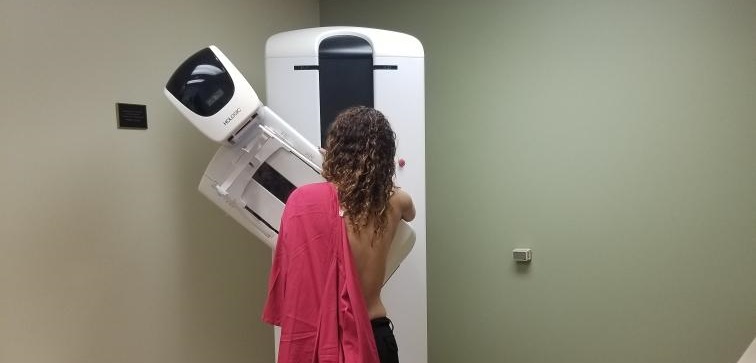
About 3D Mammography
 We are proud to have been the first hospital in the area to offer 3D mammography
to our community. 3D mammography also known as tomosynthesis is a new
screening and diagnostic breast imaging tool designed to improve the early
detection of breast cancer. The procedure for a 3D mammogram exam consists
of an x-ray arm sweeping over the breast, the arm takes multiple images
per second. The images have a series of thin slices that can be viewed
by our radiologists at various angles and as individual interactive animation images.
We are proud to have been the first hospital in the area to offer 3D mammography
to our community. 3D mammography also known as tomosynthesis is a new
screening and diagnostic breast imaging tool designed to improve the early
detection of breast cancer. The procedure for a 3D mammogram exam consists
of an x-ray arm sweeping over the breast, the arm takes multiple images
per second. The images have a series of thin slices that can be viewed
by our radiologists at various angles and as individual interactive animation images.
What are the benefits of using 3D mammography technology?
Many studies have substantiated superior breast cancer detection rates when 3D mammography is used instead of the conventional 2D mammography. Studies have shown an increase of up to 30% increase in overall breast cancer detection over 2D imagining. This allows for earlier breast cancer detection which saves more lives. Improving the early detection of breast cancer provides peace of mind due to greater clarity and accuracy. The accuracy reduces the number of call-backs (by as much as 60%), this spares women the anxiety and inconvenience of further imaging.
What makes a 3D mammography different than 2D?
2D mammography takes two-dimensional images of the breast only. However, 3D mammography allows our radiologists to examine the breast tissue one thin layer at a time, similar to flipping pages of a book. Small and fine details are more visible and are less likely to be hidden by overlapping tissue.
Is the radiation exposure grater with 3D mammography?
Radiation exposure to the breast is very low with a 3D Mammography. The radiation dose for a 3D mammography exam is well below the acceptable limits defined by the FDA, the exposure with a 3D mammography is a fraction of the radiation levels ever person receives annually from being outdoors. No evidence has shown that this low level of radiation has any effect on the breasts.
Is 3D mammography available to all patients?
Yes, this technology that has become the new level of care and is available to all patients for screening and diagnostic mammograms.
What can I expect during a 3D mammogram exam?
Additional breast compression is not required and it only takes a few more seconds than standard 2D Mammography. The experience is very similar to mammograms patients have had in the past. As is normal with any mammogram exam, some women experience minor discomfort and others experience no discomfort at all.
Do women still need an annual screening with a 3D Mammography?
Yes. All women are at risk for breast cancer, regardless of symptoms or family history. Mammograms often can detect potential problems before they can be felt. Early detection greatly increases treatment options and the likelihood of successful recovery. 3D combination exams have been proven to detect more cancers; our Breast Health Center continues to support the American Cancer Society’s guidelines which recommend that women 40 and older receive a routine screening mammogram every year.
Do I still need an annual mammogram when 3D mammography has an improved cancer detection rates?
Yes, breast cancer is the most diagnosed cancer in women; it affects one in every eight women in the U.S. The goals of breast screening exams is to identify as early as possible any breast abnormalities, this makes early cancer detection easier and provides physicians and patients with more treatment options which lead to a better chance of survival. Annual mammography will help detect subtle findings. 93 percent of all women whose breast cancer is detected at an early stage have a much greater survival rate in the first five years.
If I’m pregnant, can I still have a 3D mammography?
It is important that all patients inform their technologist before an exam about being pregnant or the possibility of being pregnant.
Is 3D mammography safe for women with breast implants?
Yes. 3D mammography is safe for women with breast implants. The majority of breast implants are designed to withstand several hundred pounds of pressure. A mammogram generates about 20 lbs. of pressure.
